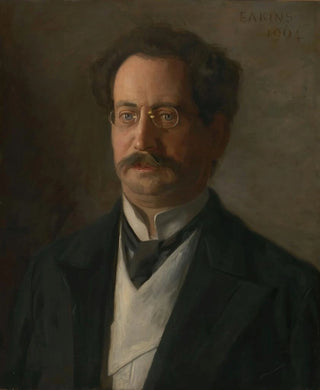Art print | Portrait of Samuel Myers - Thomas Eakins


View from behind

Frame (optional)
Samuel Myers Portrait - Thomas Eakins – Engaging Introduction
The "Samuel Myers Portrait" by Thomas Eakins is a piece that transcends the simple frame of a portrait to immerse the viewer in a universe where intimacy and the subject's psychology are beautifully captured. Created at the end of the 19th century, it reflects an era when art mirrored social and cultural evolutions. Through this portrait, Eakins does not merely depict a man; he explores the human condition, identity, and the nuances of personality. Samuel Myers, a friend and model of the artist, thus becomes the conduit for a rich and complex artistic expression, inviting everyone to ponder the depth of representation.
Style and uniqueness of the work
The piece stands out for its striking realism, characteristic of Eakins' style. With an unparalleled mastery of light and shadow, the artist manages to bring his subject to life, creating a palpable atmosphere. The meticulous details of Myers' face, his emotionally charged eyes, and his thoughtful expression reveal a sensitivity that few artists of the time could capture. Eakins employs a palette of earthy colors, enhancing the authenticity and psychological depth of the art print. Every brushstroke seems to tell a story, evoking the struggles and triumphs of an individual, while engaging in a broader dialogue about humanity. This art print is thus an invitation to contemplation, a window into the soul of the model.
The artist and his influence
Thomas Eakins, a prominent figure in American art, left a mark on his era through his boldness and innovation. Trained in Paris, he integrated European techniques while developing a distinctive style rooted in American reality. His approach to portraiture, often focused on male figures, reflects not only his artistic vision but also the values of his time. Eakins had a significant impact on the art scene, inspiring generations of artists to explore the psychology of their subjects. His commitment to truth and authenticity in art paved the way for later movements, making him an essential figure in art history. Through works like the

Matte finish

View from behind

Frame (optional)
Samuel Myers Portrait - Thomas Eakins – Engaging Introduction
The "Samuel Myers Portrait" by Thomas Eakins is a piece that transcends the simple frame of a portrait to immerse the viewer in a universe where intimacy and the subject's psychology are beautifully captured. Created at the end of the 19th century, it reflects an era when art mirrored social and cultural evolutions. Through this portrait, Eakins does not merely depict a man; he explores the human condition, identity, and the nuances of personality. Samuel Myers, a friend and model of the artist, thus becomes the conduit for a rich and complex artistic expression, inviting everyone to ponder the depth of representation.
Style and uniqueness of the work
The piece stands out for its striking realism, characteristic of Eakins' style. With an unparalleled mastery of light and shadow, the artist manages to bring his subject to life, creating a palpable atmosphere. The meticulous details of Myers' face, his emotionally charged eyes, and his thoughtful expression reveal a sensitivity that few artists of the time could capture. Eakins employs a palette of earthy colors, enhancing the authenticity and psychological depth of the art print. Every brushstroke seems to tell a story, evoking the struggles and triumphs of an individual, while engaging in a broader dialogue about humanity. This art print is thus an invitation to contemplation, a window into the soul of the model.
The artist and his influence
Thomas Eakins, a prominent figure in American art, left a mark on his era through his boldness and innovation. Trained in Paris, he integrated European techniques while developing a distinctive style rooted in American reality. His approach to portraiture, often focused on male figures, reflects not only his artistic vision but also the values of his time. Eakins had a significant impact on the art scene, inspiring generations of artists to explore the psychology of their subjects. His commitment to truth and authenticity in art paved the way for later movements, making him an essential figure in art history. Through works like the






